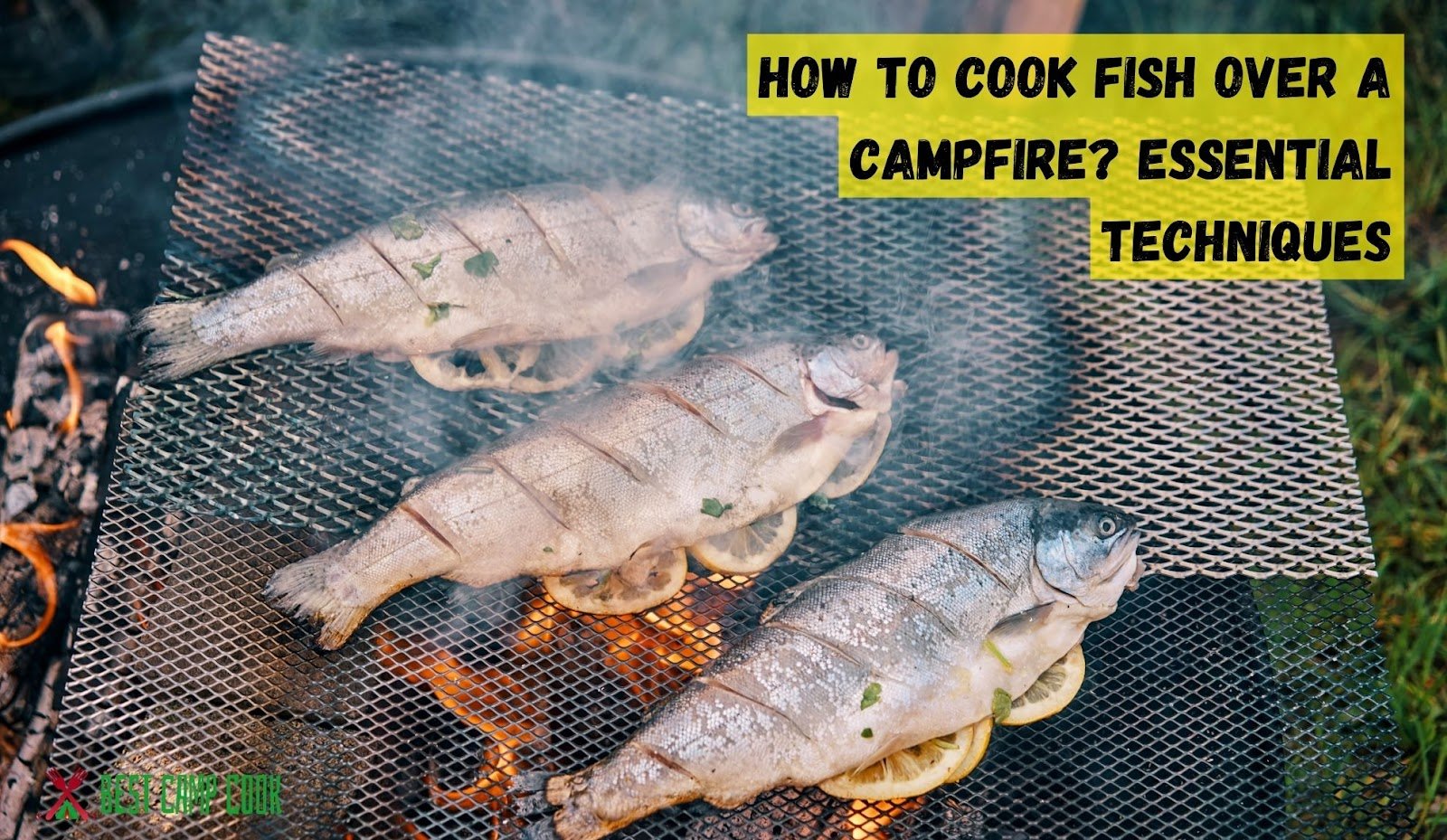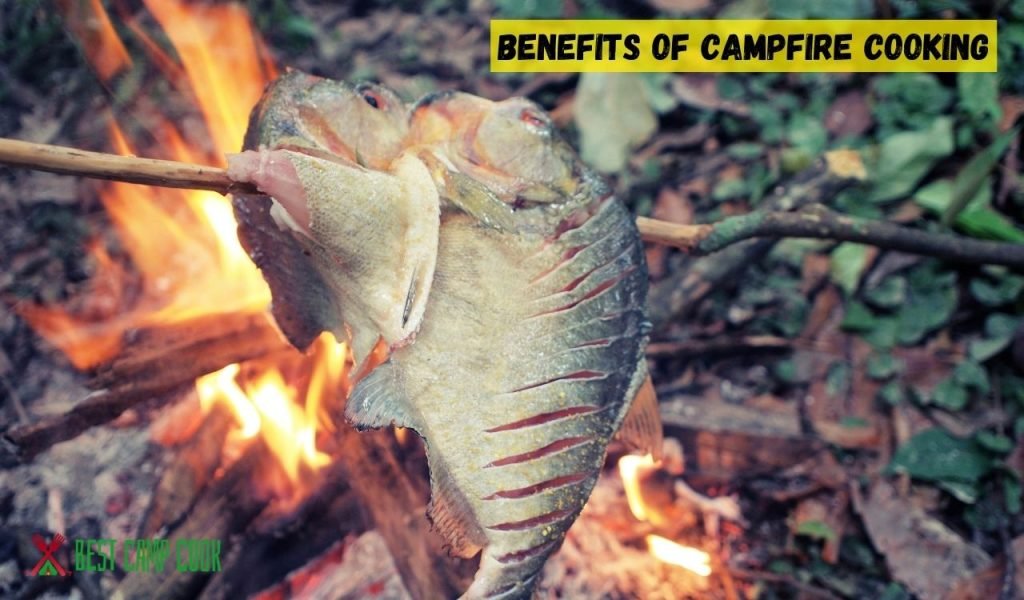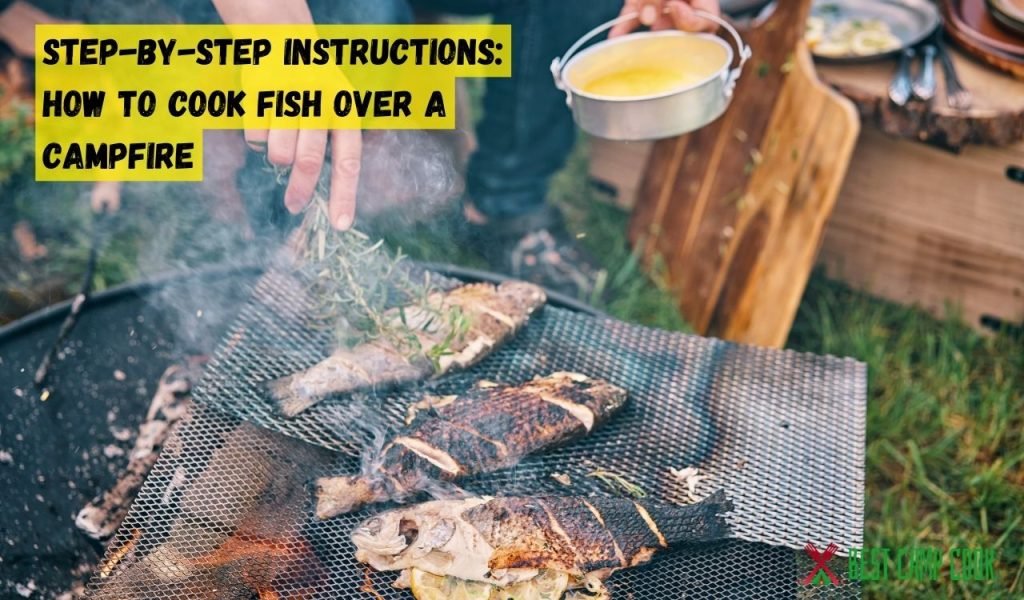Physical Address
304 North Cardinal St.
Dorchester Center, MA 02124
Physical Address
304 North Cardinal St.
Dorchester Center, MA 02124

Get ready to fire up your taste buds with the ultimate outdoor cooking experience: ‘how to cook fish over a campfire.’ Imagine the smoky aroma, the sizzle of fresh catch, and the thrill of cooking beneath the stars. In this guide, we’ll unveil the secrets of crafting the perfect campfire fish dish.
Whether you’re a seasoned outdoorsy chef or a first-time camper, this adventure promises flavors that’ll leave you hooked. So, gather ’round the flames, and let’s dive into the world of open-fire culinary magic!
Main Summary: How to Cook Fish Over a Campfire?
Begin by preparing your fish, ensuring it’s cleaned and seasoned to your liking. Next, create a robust campfire with hot coals. You can use a grill grate or wrap the fish in aluminum foil to cook it over the open flame. Let it cook for about 10-15 minutes, turning occasionally to ensure even cooking.
Cooking fish over a campfire is a time-honored outdoor tradition that combines the pleasures of adventure with the satisfaction of a delicious, freshly prepared meal. It’s a culinary experience that transcends the ordinary, immersing you in nature’s embrace as you transform a humble fish into a mouthwatering masterpiece.
Imagine the crackling of the campfire, the scent of wood smoke in the air, and the serene backdrop of wilderness. This is the ambiance that sets the stage for campfire fish cooking—a skill that not only fills your belly but also nourishes your soul.
In this guide, we’ll delve into the art of cooking fish over an open flame, from selecting the perfect campfire location to savoring the final bite. You’ll discover the essential equipment, ingredients, and techniques needed to create a campfire-cooked fish dish that’s bursting with flavor and cooked to perfection.
Whether you’re a seasoned outdoors enthusiast or a beginner in the world of campfire cuisine, this journey will ignite your culinary spirit. So, gather ’round the fire, embrace the adventure, and let’s embark on a flavorful odyssey of campfire fish cooking.

Campfire cooking is not just about preparing a meal; it’s a holistic experience that offers a range of benefits. Let’s explore them in detail:
Campfire cooking allows you to immerse yourself in the natural world. From gathering firewood to tending the flames, the process fosters a profound connection with the environment, providing a break from the fast-paced modern world.
Cooking fish over an open flame adds an element of adventure to outdoor experiences. It’s a hands-on activity that harks back to our ancestors’ survival skills, infusing your camping trip with excitement.
Food cooked in the great outdoors boasts freshness and flavor that’s hard to replicate at home. The smoky essence imparted by the campfire enhances the taste of ingredients, elevating your culinary experience.
Campfire cooking often involves collaboration, fostering teamwork and bonding. Sharing stories and laughter around the fire while enjoying a meal you’ve prepared together strengthens your connections.
Tending to the fire and focusing on the cooking process can be a meditative and stress-reducing activity. It allows you to unwind and fully immerse yourself in the present moment.
Campfire cooking encourages self-sufficiency and resourcefulness. You learn to adapt to your surroundings, boosting your confidence in outdoor settings.
Responsible campfire cooking practices, such as using fallen branches for firewood and leaving no trace, promote environmental awareness and stewardship.
Campfire cooking invites culinary creativity. With limited resources, you’ll find inventive ways to prepare and present your meals, resulting in delicious and surprising dishes.
Campfire cooking offers a precious opportunity to unplug from digital distractions and embrace a simpler way of life. It allows you to enjoy the crackling flames and the beauty of the natural world without interruptions.
Before you embark on your campfire fish cooking adventure, it’s crucial to assemble the right equipment and gather the essential ingredients. Here’s a detailed look at what you’ll need:
Begin by selecting an appropriate location for your campfire. If you’re at a designated campsite, utilize the provided fire pit or ring. In the wilderness, ensure you adhere to local regulations concerning open fires.
Collect a mix of firewood, including hardwood for a steady, long-lasting burn and softwood for kindling. Proper firewood preparation is essential for achieving the right heat for cooking.
A grill grate or a campfire cooking tripod with a hanging grill is indispensable for cooking fish over the flames. It provides a stable and elevated surface for your cookware.
Pack a set of cooking utensils, including tongs, a spatula, and a long-handled fork for safe and efficient handling of food over the fire.
Depending on your preference, you can use a cast iron skillet or aluminum foil packets to cook the fish. Both methods have their advantages, so choose what aligns with your campfire setup.
Don’t forget to bring your favorite seasonings and spices to enhance the flavor of the fish. Common choices include lemon, garlic, various herbs, and salt and pepper.
Safety is paramount when dealing with fire. Invest in heat-resistant gloves to protect your hands while handling hot cookware and firewood.
The centerpiece of your meal! Select your preferred fish variety, whether it’s trout, salmon, bass, or any catch of the day. Ensure the fish is cleaned and gutted, ready for cooking.
Carry a bottle of cooking oil, such as olive oil or vegetable oil, to prevent the fish from sticking to the grill. It also adds a hint of flavor and moisture to the fish.
Fresh herbs like rosemary, thyme, or dill, combined with slices of citrus (lemon or lime), can elevate the flavor of your campfire-cooked fish to a new level of deliciousness.
If you desire a well-rounded meal, consider adding vegetables to the mix. Favorites include asparagus, bell peppers, and zucchini, which can be cooked alongside the fish.
If you opt for foil packets, prepare your ingredients accordingly. This may include butter, seasonings, and any vegetables or aromatics you’d like to include in the packet.
Having the right equipment and ingredients at your disposal ensures a smooth and enjoyable campfire fish cooking experience. Now that you’re well-prepared, let’s dive into the step-by-step instructions for cooking fish over a campfire.

Before you even think about cooking, ensure you’re in a suitable location for a campfire. If you’re at a designated campsite, use the provided fire pit or ring. If you’re in the wilderness, make sure to follow local regulations concerning open fires. Safety and responsibility are paramount.
Collect a variety of firewood, including hardwood for a steady, long-lasting burn and softwood for kindling. Properly preparing your firewood ensures you’ll have the right heat for cooking. Remember to gather enough wood to maintain your fire throughout the cooking process.
Building a campfire is an art. Begin by creating a base layer of kindling and softwood. Gradually add hardwood logs as the fire grows, which will provide a steady and controlled burn. Allow the fire to burn down until you have a bed of hot coals. This glowing bed of coals is essential for even and consistent heat when cooking.
Position your grill grate securely over the campfire or hang it from a sturdy tripod if you prefer that method. Ensure the grill is stable and well-supported, minimizing the risk of accidents while cooking. Safety first!
Before placing your fish on the grill, season it to your liking with herbs, spices, and citrus slices. To prevent the fish from sticking to the grill and add a layer of moisture and flavor, drizzle a bit of cooking oil on both sides.
Place the seasoned fish on the grill directly over the hot coals or in your pre-prepared foil packet if you prefer that method. Cooking times will vary depending on the thickness of the fish and the heat of your fire. As a general guideline, cook the fish for approximately 5-7 minutes per side. To flip the fish without it falling apart, use heat-resistant gloves and appropriate utensils.
If you’d like to include vegetables in your meal, add them to the grill alongside the fish. Season the vegetables with salt, pepper, and a drizzle of oil for enhanced flavor. The heat from the campfire will infuse them with a smoky, delicious taste.
To ensure your fish is cooked to perfection, use a fork to gently flake the flesh. If it easily flakes apart and appears opaque, your fish is ready to enjoy. Be cautious not to overcook, as this can make the fish dry.
Carefully remove the fish and vegetables from the grill or foil packet and serve hot. Garnish with additional herbs or citrus slices if desired. Enjoy your campfire-cooked feast!
Safety should always be a top priority when cooking outdoors and dealing with fire. Here are some essential safety precautions to keep in mind:
By adhering to these safety precautions, you can enjoy the experience of cooking over a campfire while minimizing risks to yourself, others, and the environment. Responsible outdoor cooking and fire management are essential for a safe and enjoyable camping experience.
In conclusion, mastering the art of cooking fish over a campfire is a delightful journey into the world of outdoor culinary magic. From choosing the right fish to perfecting your grilling techniques, you’ve learned the essentials. Now, armed with this knowledge, venture into the wilderness, gather around the flickering flames, and savor the unique flavors of campfire-cooked fish.
Whether you’re a seasoned outdoor enthusiast or a novice camper, there’s something truly special about creating a delicious meal in the heart of nature. So, go ahead, ignite your campfire, and let the aroma of smoky, grilled fish fill the air as you relish the joys of open-fire cooking. Happy cooking, and may your outdoor dining experiences be filled with warmth, flavor, and unforgettable moments!
When selecting fish for campfire cooking, consider varieties like trout, salmon, or bass. Opt for fresh fish if possible, ensure it’s cleaned and gutted, and choose species that suit your taste preferences. Fresher fish typically yield better results over the flames.
Yes, you’ll need some essential equipment, including a campfire pit or ring, firewood, a grill grate, cooking utensils, a cast iron skillet or foil packets, seasonings, heat-resistant gloves, and, of course, fresh fish. These items ensure a successful campfire fish cooking experience.
The cooking time varies based on the fish’s thickness and the heat of your fire. As a general guideline, cook fish for approximately 5-7 minutes per side. The internal temperature should reach 145°F (63°C) to ensure safe and delicious results.
Prioritize safety by choosing a safe campfire location, clearing the area of flammable materials, having a water source or fire extinguisher on hand, and wearing appropriate clothing. Never leave the fire unattended, and be mindful of wind conditions that can affect the flames.
If you encounter unexpected weather, adapt to the situation by having a backup plan. Consider using windbreaks, rain covers, or portable stoves as alternatives to cooking over an open flame. Safety should remain a top priority in adverse weather conditions.
Cooking fish over a campfire during a fire ban or in fire-restricted areas is generally not allowed. Check local regulations and consider alternative cooking methods such as camp stoves in such situations to avoid violating fire restrictions.
To grill fish over a campfire, place the fish directly on a grill grate over hot coals. Season it to your liking, flip it carefully using heat-resistant tools, and cook until it easily flakes with a fork. Grilling imparts a smoky flavor to the fish.
For frying fish over a campfire, use oils with high smoke points like vegetable oil, canola oil, or peanut oil. These oils can handle the high heat of an open flame and help achieve a crispy exterior while retaining moisture.
Cooking over a campfire can be challenging but rewarding. It requires some preparation, knowledge of fire management, and outdoor cooking skills. With practice and the right equipment, you can enjoy delicious meals in the wilderness.
Overboiling fish can lead to dry, flavorless, and mushy results. It’s essential to avoid overcooking to maintain the fish’s texture and taste. Monitor the cooking time closely and check for doneness by gently flaking the fish with a fork; it should easily separate into flakes when done.